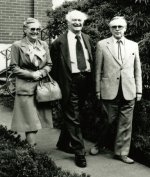
When David Shoemaker was offered the position of Chemistry Department Chair at Oregon State University in 1970, he accepted and they moved to Corvallis, Oregon. She supported this move to advance his career and seemed not to have had any regrets about the possible effects on her own career. At first Clara was not allowed to continue her collaborative work with her husband at OSU because of the "nepotism rules" of the University. To get around this barrier, an arrangement was made for Clara to work for and be supervised by Professor Ken Hedberg and for Professor Hedberg's wife Lise to work for David Shoemaker. Hedberg and Shoemaker had been classmates at Caltech, and Hedberg was on the search committee for the Department Chair at OSU. This arrangement lasted for several years until the rules were relaxed and the Shoemakers could continue to openly collaborate and work together at OSU, where they shared an office until his death in 1995.
David and Clara Shoemaker published 36 scientific papers together as well as review articles, and an assortment of other publications. Clara also published with graduate students at OSU over the years as she trained some of them to do X-ray crystallography. In fact, Clara Shoemaker's name is still displayed on the list of faculty posted at the entrance to the Chemistry Building at OSU. She is an emeritus professor and retains space in a large office of the Hedberg Group in the basement of Gilbert Hall.
Clara clearly received a great deal of satisfaction from her many years of work on metals and their phases. She seemed to have no regrets that she spent her career as part of a collaborative couple and, in fact, she felt that her work on metal phases was particularly interesting and exciting.
Clara described her work during those years in the following words. "The transition metal phases we were working on had only tetrahedral interstices between the atoms (we coined the name "tetrahedrally close-packed"), and four coordination polyhedra, the most prominent ones being icosahedra. People wondered why we kept working on these more and more complicated phases, whose only practical interest seemed to be that their presence caused brittleness in steels. We derived some pleasure out of the discovery later that some of these materials could be used as storage materials for hydrogen, the hydrogen occupying some of the tetrahedra. Interest grew when in 1984 quasicrystals were discovered which to the amazement and displeasure of some crystallographers showed icosahedral symmetry of the diffraction pattern. This then focused some attention on the icosahedra and their packing in our tetrahedrally close-packed alloy phases."
The Shoemakers' son now teaches English History in Sheffield, England. Clara finds this rather ironic, since he was born, raised and educated in the United States. His wife teaches Yugoslavian history in London, and they have a 7-year-old son.
The final thing Clara wanted to tell me about was her last meeting with Dorothy Hodgkin. In 1993 Clara attended a conference on quasicrystals in China that followed the International Union of Crystallography meeting in China, which a very frail Dorothy Hodgkin attended under the constant care of her daughter Elizabeth along with Guy and Eleanor Dodson. Hodgkin was not at all well at this point, but she said she would "rather die in China than not attend the meeting." Clara's schedule was constrained by her responsibilities for her ailing husband in Oregon, who was not able to attend either of the two crystal conferences that were taking place back-to-back in China. Clara arrived in China just in time to see Dorothy as she and her retinue were preparing to leave. Her daughter was packing and arranging things for their departure, but schedules were worked out so that Clara could meet with her old friend Dorothy for the last time. Dorothy asked about Clara's husband and her son, as usual remembering and caring about the personal details of her colleagues' lives, a trait for which she was always known and admired. Clara obviously cherished this memory of Dorothy, who died about a year later, leaving behind an international family of X-ray crystallographers devoted to the memory of this powerful and legendary matriarch.
Since that meeting between Clara and Dorothy many changes have taken place. Dorothy Hodgkin died on July 29, 1994 and David Shoemaker died a year later. Clara continues some of her professional activities. Clara has excellent recall and memory for many of the details of her early life and her career as an internationally recognized crystallographer. She is a resource and an inspiration to those of us who have come after her in the pursuit of science. She provides an important picture of the women scientists whose education and training spanned the war years in Europe, as well as women who contributed to meaningful scientific projects and accomplishments in the 1940's and 1950's in the United States.


